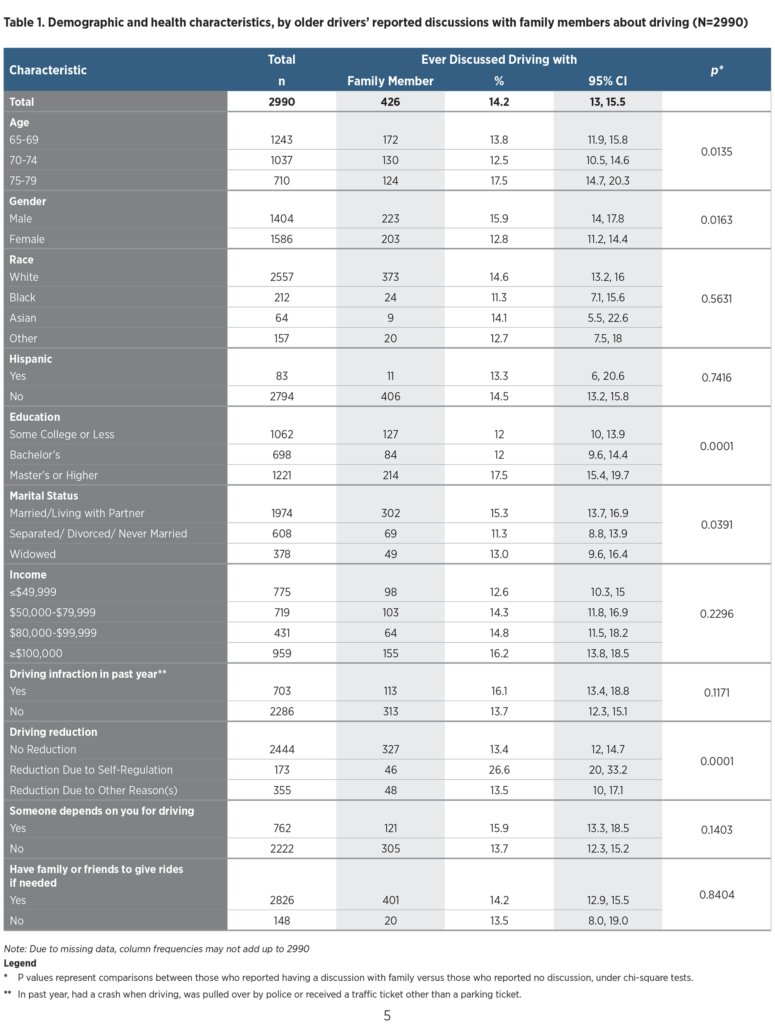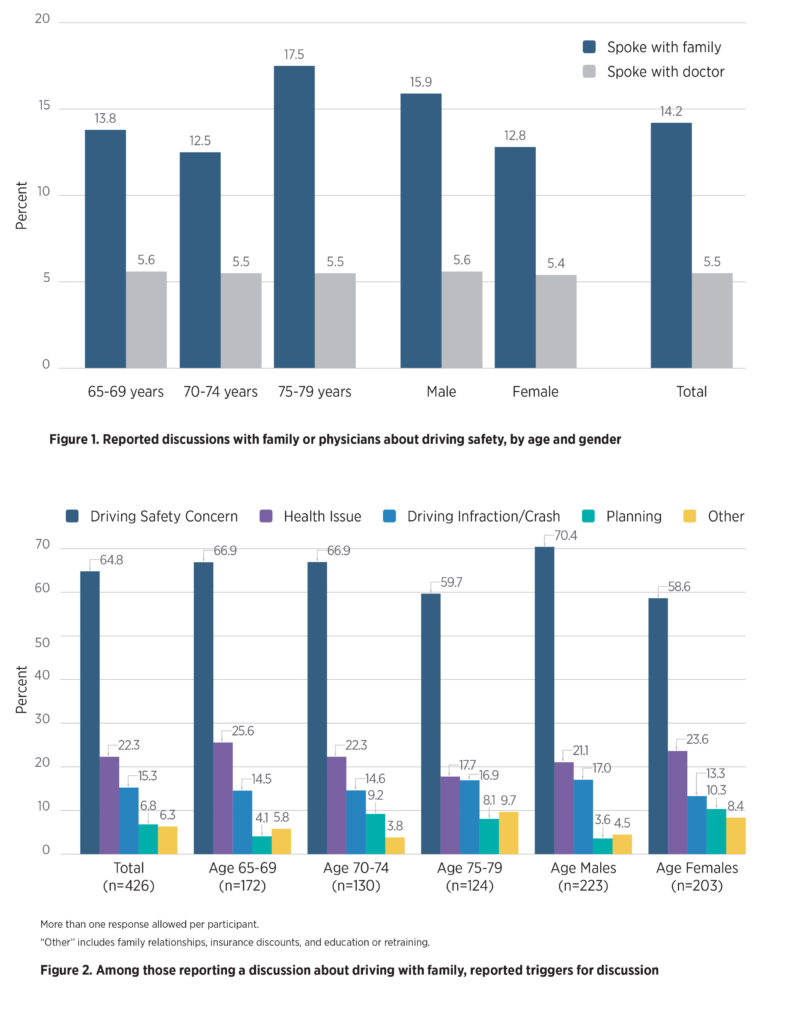
Discussions with Older Family Members about Safe Driving: Findings from the AAA LongROAD study
This research brief presents findings on the frequency of, and reasons for, older drivers having discussions with family members about safe driving.
August 2018
Suggested Citation
For media inquiries, contact:
Tamra Johnson
202-942-2079
TRJohnson@national.aaa.com
Abstract
Introduction
This research brief used baseline data from the Longitudinal Research on Aging Drivers (LongROAD) study to examine the frequency of, and reasons for, older drivers having discussions with family members about driving safety. Prior studies suggest that many older adults outlive their safe-driving ability and need to transition to other forms of mobility, and family members are often involved in the decision to continue or stop driving. This brief presents findings on conversations with family about safe driving as reported by 2,990 drivers ages 65-79 in fi ve states, along with the reasons for the discussions. Overall, 82.7% of aging drivers had not spoken with a family member or physician in the past about driving safety. Within this cohort, only 14.2% had spoken with a family member at some point in the past about their driving safety and only 2.2% of the drivers said someone had, in the past year, suggested they limit their driving. The majority (60.6%) of these conversations were initiated by family members, and they were commonly triggered by a driving safety concern (43.8%).
Key Findings
- 82.7% of aging drivers had not spoken with either a family member or physician about driving safety
- 14.2% had spoken with a family member at some point in the past about their driving safety, while 5.5% had spoken with a physician
- 2.5% spoke with both a family member and with a physician
- 2.2% of the drivers said someone had, in the past year, suggested they limit their driving
- Majority of family conversations (60.6%) about driving safety are initiated by family members, and they were most commonly triggered by a driving safety concern (43.8%)
- Conversations with family members were significantly more common among those ages 75-79 (17.5%, versus 13.2% among younger age groups) and among men (15.9%, versus 12.8% among women)
- Conversations with family were also more commonly reported by those who were married or living with a partner (15.3%) versus those who were not (12.0%).
Methodology
Cross-sectional baseline data from the LongROAD study was used. This data was designed to examine safe driving among older adults, including the influences of social, mental and physical health, as well as medical and behavioral factors. LongROAD enrollment occurred in five sites (Ann Arbor, Michigan; Baltimore, Maryland; Cooperstown, New York; Denver, Colorado; and San Diego, California). The study collects self-reported and objectively measured data on health, functioning and driving behaviors, as described in detail elsewhere
(Li et al., 2017).
At enrollment, research staff administered questionnaires about health, functioning and driving. Questions concerning discussions surrounding driving safety were used for the analysis. This also included questions about what triggered these discussions, and any recommendations after these discussions. For a point of comparison, drivers were asked if they had, at any point in the past, discussed driving safety with their family doctor or any other doctor. Additional variables of interest included demographic characteristics, self-report of driving reduction and driving experiences.
Results
Among the 2,990 LongROAD study participants, 41.6% were 65-69 years old, 34.7% were 70-74 and 23.7% were 75-79 (Table 1). Approximately half (53.0%) were female; most were non-Hispanic and white. A majority were married, had yearly incomes of at least $50,000 and had at least a bachelor’s degree (Table 1). Only 2.2% indicated that in the past year, someone suggested they limit their driving. Regardless of whether they had spoken with someone about driving safety, 337 (11.3%) participants reported decreasing their driving due to any health condition(s) in the past year.
Overall, 17.3% of participants said they had ever spoken with a family member or physician, more commonly a family member (14.2%) than a physician (5.5%; Figure 1), about driving safety. Seventy-four participants (2.5%) had spoken with both a family member and a doctor. These overall patterns were similar across genders and age groups (Figure 1), but conversations with family members were significantly more common among those ages 75-79 (17.5% versus 13.2% among younger age groups) and among men (15.9% versus 12.8% among women; Table 1). Conversations with family were also more commonly reported by those who were married or living with a partner (15.3%) versus those who were not (12.0%). Those who reported having reduced their driving due to self-regulation were also much more likely to report having had a discussion with family (26.7% versus 13.5%), although we could not assess whether the conversation preceded or followed the self-regulation.
Compared with drivers who had discussed their driving with family, those who had not had discussions rated their driving ability higher (mean 5.95 versus 5.65, p<0.001) and their driving comfort higher (mean 5.84 versus 5.46, p<0.001). Those who had not discussed driving with families also reported having significantly fewer lapses (mean 1.75 versus 1.92), errors (mean 1.41 versus 1.54) and violations (mean 1.62 versus 1.70; all p<0.001).
The family member, rather than the older driver, had initiated the majority (60.6%) of conversations. The most commonly cited reasons were driving safety concern (64.8%), followed by a health issue (22.3%), driving infraction or crash (15.3%), and planning for the future (6.8%; Figure 2). Overall patterns were similar by age and gender (Figure 2).
Suggested Citation
For media inquiries, contact:
Tamra Johnson
202-942-2079
TRJohnson@national.aaa.com

